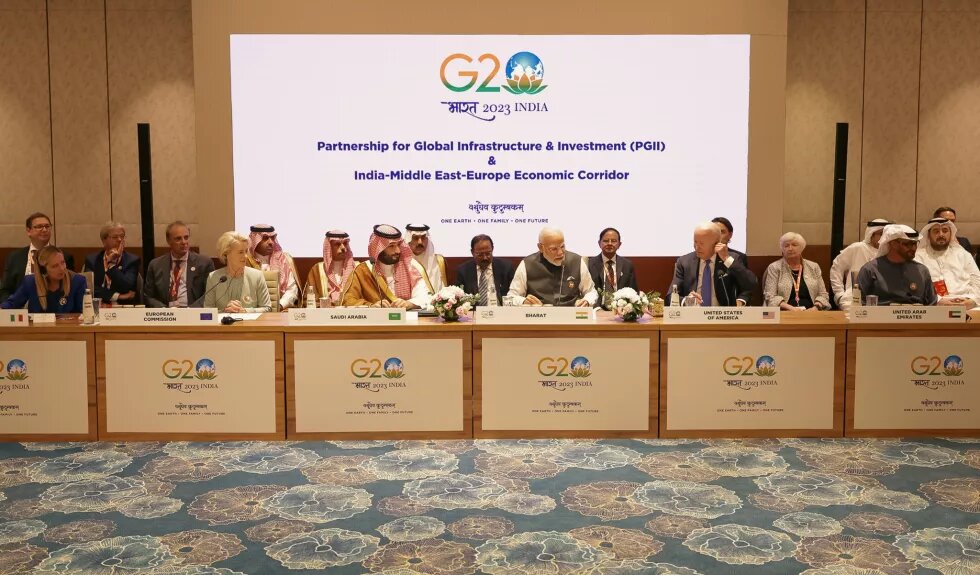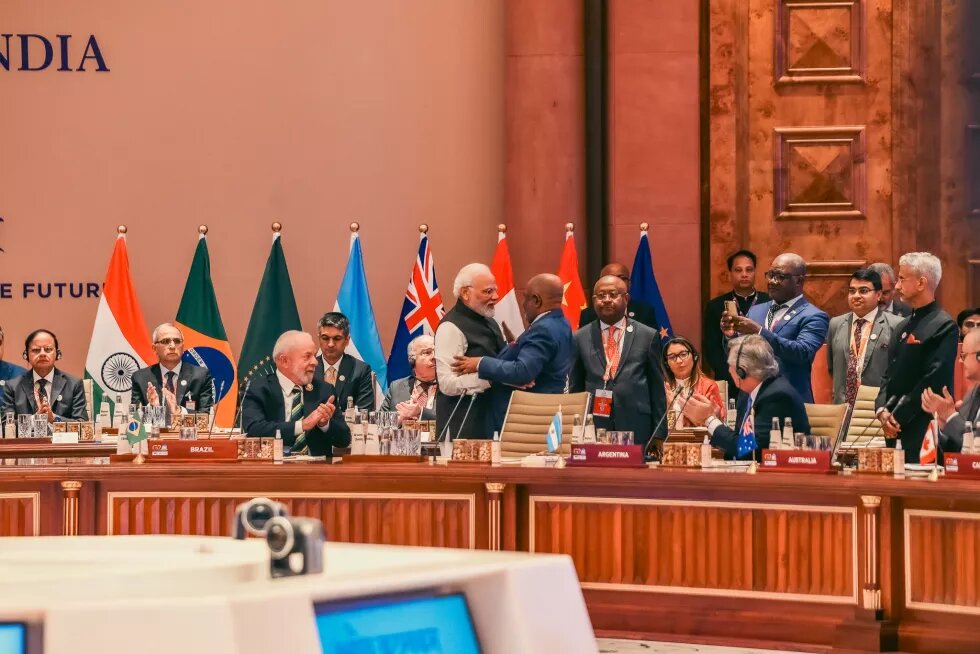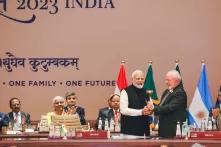
The country was effective in insulating the forum from geopolitical turbulence, making it more representative, placing the spotlight on the Global South and crafting a comprehensive blueprint of global solutions.

When the history of G20’s rotating presidencies in the first cycle (2008-2025) is written, the Indian Presidency (1 December 2022 to 30 November 2023) may be appreciated for leaving a deep imprint on G20 and the world beyond. This is due to a combination of factors: India's rise as “a democracy with development” driven by the ambition to be a leading power; its acknowledged success in tackling the COVID-19 pandemic while ensuring that the economy advances on a growth trajectory; deep commitment of the government led by Prime Minister Narendra Modi to the mandate and goals of G20, and the strong intellectual underpinnings given to the presidency, which were designed to strengthen G20, benefit India, and help the larger global community.
Future historians will no doubt record that the early 2020s represented a period of serious challenges and crises in the world economy and geopolitics that made it difficult to let multilateralism work optimally. Therefore, they may endeavour to distinguish between the short-term and the long-term effects of different leadership styles experienced by G20.
This essay offers a comprehensive analysis of India's year-long leadership. This critical examination covers the following four facets: i) the preparatory phase of deliberations, both through government mechanisms and non-official engagement groups, ii) the package of decisions concerning economic governance taken at the summit[1],iii) the post-summit evolution of the presidency, and (iv) a succinct, objective assessment.
Global context
G20 performed reasonably well in addressing the two major financial crises in 1997-1999 and 2008-2009, helping the world economy to navigate the headwinds and restore stability and normalcy. But what it faced during the second decade of the 21st century was unprecedented.
The list of challenges is long: The COVID-19 pandemic; the war in Ukraine; the serious global economic slowdown; debt stress and pressures on the price and availability of food, fuel, and fertilisers for developing nations; and, of late, the fierce military conflict between Israel and Hamas, with a risk of its degeneration into a wider regional crisis. Other developments causing negative impact were the strained bilateral relations between China and India since the border clash in June 2020, the return of the Taliban in Afghanistan, and political changes and uncertainty in parts of Africa, especially in the Sahel region. The nations holding the G20 Presidency during this period – Saudi Arabia, Italy, Indonesia, and India – had to devise strategies to address these crises and yet strive to secure G20’s wide-ranging economic agenda.
Driving philosophy, policy priorities
India's external affairs minister S. Jaishankar spoke about India's G20 priorities while addressing the UN General Assembly in September 2022. He said:
“As we begin the G20 Presidency this December, we are sensitive to the challenges faced by developing countries. India will work with other G20 members to address serious issues of debt, economic growth, food and energy security, and particularly, of the environment. The reform of the governance of multilateral financial institutions will continue to be one of our core priorities.”
Both in action and words, India's approach towards G20 was clearly spelt out at the Bali Summit in November 2022. Indian diplomats played a significant role in helping draft paras of the Bali Declaration, especially on the Ukraine issue, which led to its adoption by consensus. At the closing session, PM Modi stated:
“India is taking charge of the G20 at a time when the world is simultaneously grappling with geopolitical tensions, economic slowdown, rising food and energy prices, and the long-term ill effects of the pandemic. At such a time, the world is looking at the G20 with hope. Today, I want to assure that India's G20 Presidency will be inclusive, ambitious, decisive, and action-oriented.”
India's priorities were best reflected in the theme of India's G20 Presidency – “One Earth, One Family, One Future”. Modi assured his audience, “Over the next one year, we will strive to ensure that G20 acts as a global prime mover to envision new ideas and collective action.”[4]
The list of key priorities for India’s Presidency, as distilled from various official pronouncements, included the following:
- International peace and harmony through dialogue and diplomacy, with a focus on “human-centric development”,
- Accelerated, inclusive, and resilient growth,
- Accelerating progress on Sustainable Development Goals (SDGs),
- Green development, appropriate energy transition, climate finance, and Life for Environment (LiFE) initiative,
- Technological transformation and Digital public infrastructure,
- Gender equality and women's development,
- Reformed or reinvigorated multilateralism and heading towards an inclusive world, and
- Reform of international financial institutions.
In addition, two important motivations shaped the presidency. First, the leadership desired to showcase India's soft power – ideas, arts and culture, cuisine, and tourist treasures – to all participants in G20-related events. This was seen as a useful device to expand the arc of knowledge about India and help it increase its tourism, trade, technology, and investment linkages with the world. Second, the decision was taken to organise over 200 official events in the entire country, ensuring that all states and union territories served as hosts. This was the government’s way to engage with the entire polity, thus turning India's Presidency into a veritable “People’s G20”. This fitted well with the nation’s democratic ethos. This approach was expected to help increase the people’s awareness of the world and India's growing role in it. Many pointed out that it would also help the ruling dispensation in the assembly and parliamentary elections that were due in late 2023 and 2024.
Outcome of Working Groups and Ministerial Meetings
The core part of the presidency’s work in a year is carried by an elaborate institutional architecture comprising the Finance Track with its eight work streams, the Sherpa Track with its 13 Working Groups (WGs), and Ministerial Meetings.[5] Their deliberations conclude with the issuance of communiqués in various domains, which are annexed to the Leaders’ Declaration and form part of official documentation of each presidency. Separately from the official level, G20’s Engagement Groups, now 11 in number, operate to engage different constituencies. They end up furnishing their inputs to officials and political leaders. How was this core work handled under India's stewardship?
The answer: All the bodies mentioned above held their deliberations in various parts of the country, with a blend of diligent planning, regularity, and in considerable depth. The WGs held four meetings in the year, with their dialogues traversing the varying stages of introduction, socialisation, deep discussion, and negotiations. The last WG meetings were often combined with the meetings of ministers to secure their formal approvals for the draft communiqués.
Expectedly enough, the meetings of finance ministers and central bank governors drew much international attention because they dealt, among other items, with the reform of Multilateral Development Banks (MDBs) and the vital question of sourcing additional financing for an array of ambitious goals set by other ministers. The meeting of environment ministers, preceded by the meetings of the Environment and Climate Sustainability WG, also ranked highly, given the presidency’s focus on the nexus between environment, energy, and development. Several ministerial meetings dealing with anti-corruption, women empowerment, health, digital economy, trade and investment, and culture were held in August 2023.
All these meetings were attended by the representatives of 20 member countries, nine guest countries, and 14 international organisations (14). Many of these meetings were also the occasions for holding ‘side events’ where outside experts were invited to exchange views with officials, thereby enriching the dialogue.
Of the 11 engagement groups, a few attracted special attention. Business20 (B20) issued a set of policy recommendations anchored around the theme of RAISE – Responsible, Accelerated, Innovative, Sustainable, and Equitable Businesses.[6] B20 recommended accelerating services trade, rolling out digital public infrastructure, driving the inclusion agenda, and creating new institutional mechanisms such as the B20 Global Institute, Financing De-Carbonisation, and Global SDG Acceleration Fund (GSAF).
Think20 (T20), a platform for G20’s think tanks, issued a thoughtful communiqué, highlighting its considered views on catalysing climate finance and accelerating SDGs. On “Reformed Multilateralism”, T20 recommended establishing “an expert group” with a mandate to devise concrete proposals for global governance reform, especially the UN Security Council.[7]
Civil20 (C20), in its succinct communiqué, affirmed “the imperative of equality, humanity, and justice”, offered the motto of “Building Back Stronger and Better” and sought to promote the core principles of inclusiveness and human-centered approaches.[8]
Two additional observations are in order here. First, the Sherpas’ meetings throughout the year played a vital role in the coordination of various meetings and eventually in the successful negotiation of the G20 New Delhi Leaders’ Declaration (NDLD). Second, under the Indian Presidency, a new WG on Disaster Risk Resilience and Reduction was established, and a new engagement group – ‘Startup20’ – was also created.
Summit decisions
The New Delhi Summit’s decisions on a range of economic and developmental issues need a critical look. G20’s candid assessment of the global economy is that the growth is “below its long-run average and remains uneven.” As a result, “uncertainty around the outlook remains high.”[9] The summit’s prescription is to promote strong, sustainable, balanced, and inclusive growth, which assigns a crucial role to private enterprises including start-ups and micro, small and medium enterprises (MSMEs); unlocks trade for growth including WTO reform; advances financial inclusion; and fights corruption. Noting frankly that the global progress on SDGs is “off-track with only 12 per cent of the target on track”, G20 resolved to “fully and effectively implement the 2030 agenda”. Inter alia, it decided that focus will be placed on strengthening the global health architecture and implementing the “One Health based approach.”[10]
A vital component of the New Delhi package is “the Green Development Pact” for a sustainable future. Recognising the insufficiency of the Paris Agreement's goal to hold the increase in the global average temperature to below 20 C above the pre-industrial level, the decision was “to pursue efforts to limit the temperature increase to 1.50 C”. The pathways to achieve this ambitious goal include maintaining Lifestyles for Sustainable Development (an Indian contribution); designing the circular economy; harnessing the ocean-based economy; implementing just and affordable energy transitions; and delivering on climate and sustainable finance. Para 41 calling for an increase in investment and climate finance from “billions to trillions globally from all sources” and explaining how additional financial resources will be arranged drew a mix of attention, hope, and scepticism. While developed countries are yet to fulfil their 2010 commitment to mobilise US$ 100 billion per year by 2020, the leaders noted the need for “US$ 5.8–5.9 trillion” in the pre-2030 period required for developing countries. They expected developed countries’ contributions to reach US$ 100 billion for mitigation this year, “for the first time in 2030”. In addition, “US$ 4 trillion per year” was needed for clean energy technologies by 2030 to reach net zero solutions by 2050.[11]
The question of finance has been linked to the reform of the MDBs to which much attention and effort were devoted, mainly through the independent expert group co-chaired by Laurence Summers (US) and N.K. Singh (India). In a two-volume report, the panel presented a roadmap on how to create “bigger, better, and bolder MDBs”. Five key ways suggested were: Scaling up financial capacity, boosting joint action on climate, enhancing country-level collaboration, strengthening co-financing, and deepening MDBs’ ambition to cooperate to boost private capital mobilisation.[12] Notably, at the meeting of finance ministers and central bank governors in Marrakesh in October 2023, ten leading MDBs welcomed the above report and announced their intention to explore the expansion of their lending capacity with “an additional headroom of US$ 300-400 billion in the next decade”.[13]
The debt burden issue received concentrated attention. Para 54 of the NDLD has encapsulated the outcome of deliberations among the finance ministers and others. While no new initiative such as the Debt Service Suspension Initiative (DSSI)[14] announced in May 2020, it was crafted now, with the members reiterating the commitments made in the “Common Framework for Debt Treatments beyond the DSSI”. The objective of addressing debt vulnerabilities in low and middle-income countries “in an effective, comprehensive and systematic manner” remains unchanged. A specific reference was made to the situation of four countries: Zambia, Ghana, Ethiopia, and Sri Lanka. The NDLD stressed two other important points: i) joint efforts are needed, including by private creditors, on debt transparency; and ii) better communication and “a common understanding” were essential among “key stakeholders” to determine the nature and size of debt vulnerability and craft suitable solutions.[15] Is this approach adequate, given the gravity of the problem?
In the above context, a fresh look at the report entitled “Debt Relief by Multilateral Lenders: Why, How and How Much?” is advisable. A principal conclusion drawn by the authors of this report is: “We find that MDB participation in debt restructuring could help unlock a multifold amount of relief by other creditors where debt relief would have greater leverage than new lending.”[16] What the MDBs do to reform themselves in the near future needs to be watched closely, not only for providing additional financial resources for development and climate challenges but also for reducing the debt vulnerability of developing countries.
Finally, the summit made some decisions on the digital public infrastructure by welcoming a broad framework on it, India's plan to maintain a global repository, and noting the Indian proposal of One Future Alliance (OFA) to assist developing countries. Another goal, pursued with vigour by India, was to secure gender equality and women-led development. This was assigned “fundamental importance”, and the implementation was spelt out in Para 64.
On the sidelines of the summit, two important decisions were announced that added substance to the success of the summit. First, the leaders of India, the US, Brazil, and six other countries launched the Global Biofuel Alliance (GBA) to expedite the global uptake of biofuels through cooperation on a wide spectrum. Second, a cluster of nations including India and the US announced the launch of the India-Middle East-Europe Economic Corridor (IMEC) connecting India through the Gulf to Europe. Both initiatives are likely to have a long-term impact on the development of the participating countries and regions. The outbreak of the Israel-Hamas war and the escalation of tensions in West Asia, however, raised serious doubts about the viability of IMEC in the short term.
Post-summit developments
Four important developments that followed the New Delhi Summit may also be analysed briefly.
First, under the G20 University Connect programme, Indian universities hosted over 100 lectures throughout the year on the G20 themes, as part of a campaign to raise awareness among the youth. The finale, a mega-conference, was organised on 26 September 2023 at the same venue in New Delhi where the G20 summit was held. Addressing some 3,000 members of the university community, PM Modi noted that India's diplomacy had “scaled new heights in the past 30 days”. During the month ending in the summit (9-10 September), the PM met 85 world leaders. He referred to NDLD, the GBA, and the IMEC as significant achievements. He credited the positive developments taking place in the country to “the political stability, policy clarity and democratic values”.[17]
Second, Parliament20 (P20), an important engagement group, held the summit of parliamentary speakers on 13-14 October 2023.The NDLD clearly influenced its joint statement. The latter reaffirmed the speakers’ resolve “to engage in parliamentary diplomacy and dialogue” to promote international peace, prosperity, and harmony.[18]
Third, as a sequel to the first “Voice of the Global South Summit” (VOGSS) held in January 2023, India hosted the second VOGSS on 17 November 2023. Both summits were in the virtual format and innovative in nature. While the first summit was designed to obtain policy inputs for India's G20 Presidency from participants from 125 developing countries, the second summit aimed to apprise them of how the needs and concerns of the Global South were amply integrated into the G20 agenda. Besides, the significance of the admission of the African Union (AU) in G20 as a new member was deliberated upon. Over 130 countries attended the second VOGSS.
The outcome of VOGSS 2.0 was substantive. The Global South orientation of the G20 summit was fully noted at this. Perhaps over 50 per cent of the content of the G20 New Delhi Leaders Declaration (NDLD) is related exclusively to the needs of the Global South. There was recognition that the success in securing a seat for the AU in G20 demonstrated that global groupings can be persuaded to respond to the changing global realities in an inclusive fashion, as India;s foreign secretary Vinay Kwatra observed. Besides, he added, participants were clear that resolving global challenges required not confrontation but a mix of cooperation, consultation, and coordination.[19]
Fourth, the G20 Virtual Summit was convened by India on 22 November 2023. While Italy and Saudi Arabia as presidents had held a second summit during their presidencies to address the crises of Afghanistan and the COVID-19 pandemic respectively, India held the second summit without a new crisis. (The Israel-Hamas war broke out on 7 October, well after the Indian announcement to hold the summit was made on 10 September.) The virtual summit sought to achieve two goals: Take forward key outcomes and action points from the Delhi summit and push for effective implementation of various decisions announced at New Delhi, according to the G20 secretariat. An additional motivation may have been to bridge the transfer of the presidency from India to Brazil and reflect on how the G20 agenda may be shaped under a new president during 2023-24. It turned out to be a well-attended conference, with 23 of the member and guest nations participating at the Head of Government level.
In his opening remarks at the virtual summit, PM Modi asserted that India succeeded in making G20 “inclusive, ambitious, action-oriented and decisive”. He highlighted the significance of the adoption of the human-centric approach while supporting innovation and digital technology, renewal of faith in multilateralism, and AU as a new member of G20. “It is a matter of pride that Africa got a voice under India's Presidency,” he observed.
While no outcome document was issued after this summit, the Indian finance minister informed the media that reform of MDBs gained momentum; countries like the US and Germany were ready to provide additional financial resources to developing countries for development and climate change and the global framework to regulate crypto assets was ready, which G20 countries and others were expected to implement.
Assessment
Much has already been written and said about the achievements of the New Delhi Summit and the Indian Presidency in general. The consensus on the Ukraine war, AU’s admission as a new member of G20, sensitivity shown to the Global South’s perspective, and the crafting of a rich New Delhi Declaration with “100 per cent consensus” were the noteworthy features.
However, John Kirton, Director G20 Research Group at the University of Toronto, pointed out that “there were several great gaps”. He stressed that most commitments were ‘weak’, and there was “almost no new money mobilised, even for the critical urgent issues of climate change, debt relief for developing countries, global health, or food security, education and other social needs”.[20]
In a recent Brookings article, scholars Eswar Prasad and Caroline Smiltneks argued that the world economy “is losing momentum as its major engines of growth decelerate and a confluence of short-term factors and long-term constraints—including restrictive monetary policy, geopolitical tensions, high public debt levels, and aging populations—begin to bite”.[21] In this dismal scenario, decisions taken by the 18th summit of G20 deserve international support; they need to be implemented optimally and quickly. The extent to which key decisions, if implemented, bring improvement in the global economy and secure sustainable development will eventually determine the success and credibility of G20.
Despite the systemic weaknesses of G20, an informal multilateral grouping, the prescriptions of NDLD can hardly be contested. They mostly represent a prudent, practical and balanced approach to addressing the principal challenges faced by the world today and are based on optimal consensus. The key question is: Do the G20 governments confronting inter-state contestations, violent conflicts, domestic elections and various immediate crises at home have the political will to ensure follow-up action and implement the decisions announced at the New Delhi Summit?
Nevertheless, India's Presidency will be remembered as a significant milestone in the journey of the G20’s caravan for insulating the forum from geopolitical turbulence, making the G20 more representative, placing the spotlight on the Global South and crafting a comprehensive blueprint of global solutions. By engaging large sections of the polity through the length and breadth of India, the presidency transformed the forum into a ‘People’s G20’.
Conclusion
Now, a new hope emanates from the composition of the new G20 Troika for 2023-24, comprising India, Brazil, and South Africa. As the new President, Brazil will no doubt introduce changes in the G20 agenda, going by its worldview and prevailing socio-economic realities, while ensuring continuity. The Troika is expected to keep a close watch on progress in implementing the New Delhi decisions and chart the future course of G20.
The Troika, composed of the IBSA Forum members, has the onerous responsibility to deliver on the commitments made, by leveraging optimal coordination and innate solidarity. It might be remembered that although G20 stands strengthened today due to India's creative and forward-looking presidency, the forum – and indeed the entire world – continues to face serious global challenges due to a complex combination of geopolitics and geo-economics.
Obviously, one great summit is not enough; G20 needs many more, and a sustained determination to honour its commitments.
Endnotes
[1]For an evaluation of the geopolitical implications of the G20 New Delhi Summit, see this author’s article ‘Evaluating New Delhi Summit through the lens of geopolitics’, Heinrich-Böll-Stiftung, Regional Office New Delhi, 3 November 2023, https://in.boell.org/en/2023/11/03/evaluating-new-delhi-summit-through-lens-geopolitics
[2]India’s Statement delivered by the External Affairs Minister, Dr. S. Jaishankar at the General Debate of the 77th session of the UN General Assembly’, Ministry of External Affairs. 25 September 2022. https://www.mea.gov.in/Speeches-Statements.htm?dtl/35757/Indias_Statement_delivered_by_the_External_Affairs_Minister_Dr_S_Jaishankar_at_the_General_Debate_of_the_77th_session_of_the_UN_General_Assembly
[3] Prime Minister Narendra Modi’s remarks at the Closing Session of G20 Summit in Bali, November 16, 2022, G20, https://www.g20.org/en/media-resources/speeches/november-22/remarks-g20/
[4] Ibid.
[5]G20 – A Primer: Background Note Prepared for G20 University Connect, RIS, New Delhi, 2022.
[9] ‘G20 New Delhi Leaders’ Declaration’, https://www.mea.gov.in/bilateral-documents.htm?dtl/37084/G20_New_Delhi_Leaders_Declaration
[10] Ibid.
[11] Ibid.
[12] Prashant Jha, ‘MDBs agree to collaborate on finance, climate sector’, Hindustan Times,14 October 2023.
[13] Ibid.
[14]Debt Service Suspension Initiative‘, The World Bank, 10 March 2022, https://www.worldbank.org/en/topic/debt/brief/covid-19-debt-service-suspension-initiative
[15]‘G20 New Delhi Leaders’ Declaration’, https://www.g20.org/en/media-resources/press-releases/september-2023/university-connect-finale/
[16]Marina Zucker-Marques, Ulrich Volz and Kevin P. Gallagher, ‘Debt Relief by Multilateral Lenders: Why, How and How Much?’https://drgr.org/files/2023/09/DRGR-Report-2023-Digital-FINAL.pdf
[17]‘PM addresses G20 University Connect Finale’, https://www.mea.gov.in/bilateral-documents.htm?dtl/37084/G20_New_Delhi_Leaders_Declaration
[18]‘Ninth G20 Parliamentary Speakers’ Summit (P20)13-14 October 2023. New Delhi, India,
https://www.g20.org/content/dam/gtwenty/gtwenty_new/document/FINAL_P20_Joint_Statement.pdf
[19]Transcript of Special Briefing by Foreign Secretary on the 2nd Voice of Global South Summit (November 17, 2023)‘. Ministry of External Affairs, 18 November 2023. https://www.mea.gov.in/media-briefings.htm?dtl/37271/Transcript_of_Special_Briefing_by_Foreign_Secretary_on_the_2nd_Voice_of_Global_South_Summit_November_17_2023
[20]John Kirton,‘The G20 New Delhi Summit's Significant Performance’, G20 Research Group, 14 September 2023, http://www.g20.utoronto.ca/analysis/230914-kirton-performance.html
[21]Eswar Prasad and Caroline Smiltnecks, ‘October 2023 update to TIGER: The global recovery falters as major growth engines decelerate’, Brookings, 8 October 2023, https://www.brookings.edu/articles/october-2023-update-to-tiger-the-global-recovery-falters-as-major-growth-engines-decelerate/
**


